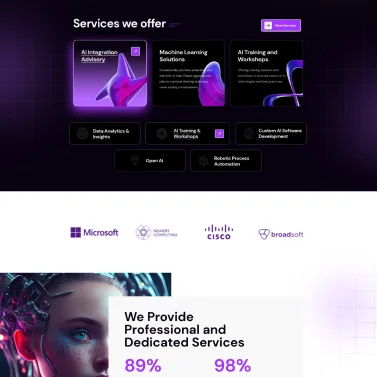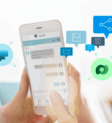Deploy Employee Experience Chatbots in Microsoft Teams

Over the past year, Microsoft customers have spent most of their time collaborating and working within Teams. Indeed, with 145 million daily active users, Microsoft Teams has emerged as the go-to platform for employees to host meetings, talk to colleagues, and send and receive project updates.
Needless to say, it makes sense for organizations to surface information that employees need within Teams and help them get day-to-day tasks done without switching contexts.
As organizations grow and mature, they amass a sea of knowledge that often gets trapped in siloed tools, SharePoint sites, FAQ documents, and other internal apps. This makes it tricky to find information, requiring employees to switch between disparate apps frequently.
Moreover, as employees work remotely, they often encounter IT and HR issues that need immediate remediation. Usually, such appeals are mundane, repetitive requests that make it difficult for support staff to focus on tasks that add business value. Additionally, it may require employees to routinely deal with specialists (IT/HR), causing frustration for both parties.
As seen above, today’s employees are living within Teams. Hence, what’s better than deploying employee experience chatbots in Microsoft Teams that can help employees fetch the required information quickly and get routine tasks done seamlessly within the same platform?
Let’s explore further.
Deploying Employee Experience (EX) Chatbots in Microsoft Teams
A chatbot embedded in Microsoft Teams can answer simple questions, guide users to relevant knowledge articles, create support tickets, help employees automate simple to complex tasks, and escalate requests to human agents when needed – all while staying within Microsoft Teams.
Getting all requests fulfilled while sitting within a single hub helps employees focus and maintain workflow without getting distracted by different browser tabs or multiple apps and tools.
What all can your employee experience chatbot do within Teams?
1. Answer employee queries instantly - anytime, anywhere!
An EX chatbot deployed within Teams can be called to answer queries, such as “How many vacation days do I have?” or “How can I set up a VPN?”
Indeed, the convenience of accessing the chatbot within Teams itself – the place where employees are spending most of their time – reduces app fatigue and boosts employee productivity.
Moreover, the chatbot is available 24X7 and can handle multiple queries simultaneously at lower costs to the organization. The employee can ask questions from anywhere from the Teams mobile app – irrespective of whether they are at home, in the office, or elsewhere.
However, if the bot fails, the system can quickly bring in a human-in-the-loop by posting a real-time alert to the subject-matter experts, who can then provide help in the moment.
Learn more here.
2. Simplify everyday tasks with the Teams chatbot
The employee experience chatbots deployed within Teams can automate simple, repetitive tasks on behalf of users. Users can scope such bots to manage a few simple commands or even complex AI-driven tasks.
Examples include – changing passwords, setting up VPN, raising tickets for outages, completing log reports, updating customer or sales database, etc.
Additionally, employees can leverage the Teams bot to simplify common HR tasks like applying for leaves, issuing asset change requests, schedule meetings, submitting onboarding documents, etc.
3. Surface relevant information within Teams
Indeed the quick and seamless discovery of relevant knowledge reduces employee fatigue and burnout and substantially improves productivity.
Employee experience chatbots can retrieve files, FAQ pages, documents, and other information from the organization’s internal network (for example, key business metrics from BI apps) and surface the content within Teams, eliminating the need to switch between apps to get work done.
4. Deliver personalized alerts
Employee experience chatbots can push notifications and alerts within Teams (for instance, latest policy updates, documents added to an existing project folder, scheduled downtime, etc.).
Such notifications are personalized based on the concerned employee’s role, geography, interests, duties, etc.
Microsoft VIVA and Employee Experience Chatbots
Launched in February 2021, VIVA, Microsoft’s employee experience platform, brings together communications, knowledge, learning, resources, and insights and builds a conducive organizational culture that empowers people and teams to be their best from anywhere.
Microsoft VIVA consists of four modules delivered through Teams – VIVA Connections, VIVA Insights, VIVA Topics, and VIVA Learning. Together, they help organizations deliver end-to-end engagement and ensure people have the knowledge and resources they need – right within the everyday workflow.
The question then arises – “How can EX chatbots work alongside VIVA to deliver a better employee experience?”
As seen above, with the increase in digitization, employees demand answers and want information instantly, at their fingertips. By working in tandem with Microsoft VIVA, EX chatbots can do just that.
For example, VIVA Topics helps organizations curate Topic Pages on different subjects, including company jargon, project names, software, etc., and surface the same across email and other apps. By harnessing AI to reason over knowledge, VIVA Topics helps organize information across content and subject-matter experts.
Now, the employee may start the conversation with the bot by saying, “What can you tell me about topic “X?”
The bot may throw up topic pages that talk in-depth about the topic “X” or may suggest employees who possess expertise on the same.
Additionally, by sending links to the latest training and other learning resources available on Topic X, employee experience chatbots can add a new layer of AI (powered by VIVA Learning) to deliver the relevant knowledge and expertise intelligently.
Another example is that of VIVA Insights. VIVA Insights delivers managers and employees data-driven recommendations to foster productivity and reduce burnout at the workplace. Here, EX chatbots can send personalized reminders to employees to take regular breaks, book focus time, and guide on closing out the day’s tasks.
On the other hand, the bot can also send insights to managers and leaders on employee productivity and work patterns and trends that minimize attrition.
Benefits of deploying EX chatbots in Teams
- Improve productivity by simplifying day-to-day tasks and providing access to all information right within Teams.
- Enhance digital employee experience for the hybrid workforce.
- Reduce employee burnout, fatigue, and employee attrition.
- Decrease costs of providing employee support at scale.
The Different Chatbot Personas in Microsoft Teams
A) IT Chatbot
- Raise tickets for service disruptions, IT outages, or requests for service outages.
- Answer common IT queries, e.g., “How do I reset my laptop password?”
- Automate IT onboarding processes, requesting preferred laptops to new users, setting up email accounts, etc.
- Automate other IT tasks, including sending outage alerts on Teams, issuing asset change notifications, and much more.
B) HR Chatbot
- Provide answers to queries – leave balance, income tax, yearly holidays, HR policies, etc.
- Simplify recruitment and onboarding activities – submitting document proofs, scheduling interviews, etc.
- Allow employees to apply for leave, schedule meetings, book travel, and much more.
C) Business Intelligence (BI) bot
- Retrieve required data from the BI app via text or multimedia (reports, graphs, dashboard screenshots, etc.). For example, “What were the operating expenses in Q3-19?
- Request for reports or dashboard links via Teams chat.
D) Intranet Chatbot
- Retrieve files, documents, and valuable knowledge from anywhere across the company’s internal network.
- Get personalized and meaningful search results from all internal apps within the intranet.
Deploy Employee Experience Chatbots in Microsoft Teams with Power Virtual Agents
Power Virtual Agents (PVA) is a low-code graphical interface solution that provides an instant, bot authoring canvas to build rich, intelligent, and responsive conversational chatbots that easily integrate within Teams.
With its low-code interface, pro and citizen developers alike, including domain specialists, business analysts, and skilled app developers, can design and publish employee experience chatbots for Teams without needing a complex development environment.
After developing the chatbot in the PVA portal, the user must publish the bot and configure the Teams channel to make it available to Teams users.
Click here to learn more about making your chatbot available in Teams through the Power Virtual Agents portal.
Prerequisites to adding a bot to Teams using Power Virtual Agents
Here are a few requirements you should be mindful of before deploying PVA chatbots in Microsoft Teams –
- Familiarity with the Power Virtual Agents platform.
- Your organization’s Teams app permission policies must allow the Power platform apps to be added to Teams.
- Before installing the bot in Teams or sharing it with others, publishing it at least once is mandatory.
Case Example —> To know how to quickly build a Microsoft Teams bot with Power Virtual Agents, do check out this video.
Deploy Employee Experience Chatbots in Microsoft Teams with BotCore
As a Microsoft Gold Partner, we, at Acuvate, help clients deploy employee experience chatbots in Microsoft Teams for various use cases, including IT, HR, Business Intelligence, intranet, etc., with our low-code enterprise bot-building platform BotCore.
Akin to Microsoft Power Virtual Agents, BotCore leverages a graphical interface and visual tools to assist users in deploying smart AI-enabled bots within Teams.
We use Microsoft’s best AI, machine learning, and natural language processing technologies, including LUIS, Azure Cognitive Services, and the Microsoft Bot Framework, to deploy employee experience chatbots in Microsoft Teams.
Our bots are multilingual and support global languages, including French, German, English, Italian, etc.
We also deploy aggregator bots to help our clients experience easy, consistent, and seamless engagement – all while sitting right within Teams.
To know more about BotCore, please feel free to schedule a personalized consultation with our chatbot experts.
Abhishek is the AI & Automation Practice Head at Acuvate and brings with him 17+ years of strong expertise across the Microsoft stack. He has consulted with clients globally to provide solutions on technologies such as Cognitive Services, Azure, RPA, SharePoint & Office 365. He has worked with clients across multiple industry domains including Retail & FMCG, Government, BFSI, Manufacturing and Telecom.







Abhishek Shanbhag